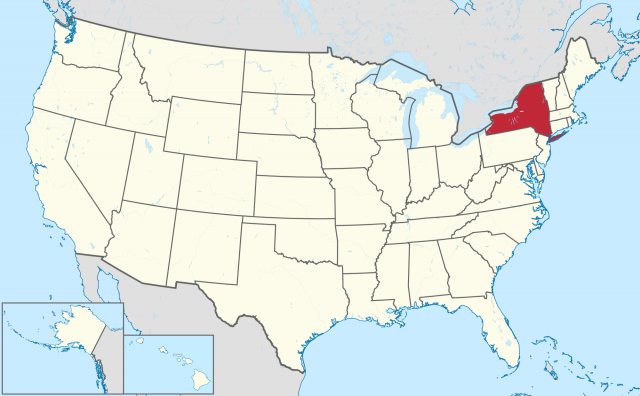New York
NEW YORK—OFTEN called New York State to distinguish it from NEW YORK CITY—is a northeastern state of the UNITED STATES, bordering VERMONT, MASSACHUSETTS, and CONNECTICUT to the east; PENNSYLVANIA and NEW JERSEY to the south; and the Canadian provinces of Ontario and Quebec to the north. Lakes ERIE and ONTARIO form the greater part of the boundary between New York and Ontario. Lake Champlain forms more than half of the boundary between New York and Vermont.
New York is roughly triangular in shape, with angles jutting north to Quebec, west to Lake Erie, and southeast toward Long Island. New York's highest point is Mount Marcy, which reaches 5,344 ft (1,629 m) in the Adirondack Mountains of the northeastern part of the state. The total area of New York is 54,556 square mi (141,299 square km), which makes the state 27th in size among the 50 states.
From 1810 through the U.S. census of 1960, New York was the largest state in population. New York's estimated 2003 population totals 19,190,115, approximately 4 out of 10 of whom live in New York City. If New York City's Long Island and northern suburbs are included, almost two-thirds of the state's population lives in the New York City metropolitan area.

New York's capital is Albany; its largest cities are New York City (with a 2000 census population of 8,008,278), Buffalo (292,648), Rochester (219,773), Yonkers (196,086), and Syracuse (147,306). New York State, and in particular New York City, dominates the nation in finance and in the publishing and fashion industries. Agriculture is important to the upstate New York economy, particularly milk production, the growing of fruits and vegetables, and the production of wine. Tourism is of great importance to New York State, with attractions ranging from Niagara Falls to the Finger Lakes, from the Adirondacks to New York Harbor's Statue of Liberty.
New York is the only state to possess shoreline on both the ATLANTIC OCEAN and the Great Lakes. The state includes four islands just offshore from the mainland. Fishers Island lies off the Connecticut coast. Long Island, which includes parts of New York City, extends eastward from New York Harbor more than 110 mi (177 km) and separates Long Island Sound from the open Atlantic. The island of Manhattan, including the business and tourist sections of New York City, lies across the Hudson River from New Jersey and across the East River from Long Island. Staten Island, which also comprises a portion of New York City, lies off the mainland of New Jersey, across New York Harbor from Long Island. These islands form part of the terminal moraine deposited by the last of the Pleistocene continental glaciers. The valley of the HUDSON RIVER, which flows into New York Harbor at New York City, extends north to the Adirondacks. The Hudson's channel, carved out to form a fjord by the Pleistocene glaciers, is a tidal stream all the way up to Albany, more than 150 mi (241 km.) from the river's mouth.
North and west of the Hudson Valley are New York State's two major mountainous areas, the Adirondacks and the Catskills. The Mohawk Valley, containing the Mohawk River (the major tributary of the Hudson), separates the Adirondacks and Catskills and stretches almost 100 mi (160 km) west from Albany to the Lake Ontario plain. Southwestern New York is a portion of the Appalachian Plateau, into which the Pleistocene glaciers carved the Finger Lakes, the largest of which are Seneca and Cayuga. Lake Erie empties into Lake Ontario through the Niagara River, which forms part of the Ontario-New York border. The difference between the elevations of these two Great Lakes, together with the large volume of water carried by the river, accounts for a spectacular vertical drop of 182 ft (55 m) at Niagara Falls.
NEW YORK STATE
Two groups of Native Americans inhabited New York State when the state was first visited by Europeans. Algonquin peoples inhabited the southeastern portions of the state. The Iroquois Confederacy (an alliance of the Seneca, Cayuga, Onondaga, Oneida, and Mohawk) dominated central and western New York. The first European settlement was established by the Dutch near Albany in 1624. This settlement soon become part of the Dutch colony of New Netherland, established in 1626 with the founding of the settlement of New Amsterdam at the southern tip of Manhattan Island. The colony of New Netherland capitulated in 1664 to the British, who changed the name of the city and colony to New York.
New York State played a major role in the American Revolution; the American victory at Saratoga is generally considered the decisive battle of the war. New York State grew rapidly throughout the 19th century, especially after the completion of the Erie Canal through the Mohawk Valley and west to Buffalo in 1825. The canal provided the easiest, most level transportation link between the northeastern states and the rapidly developing Midwest, and the commerce and influence channeled by the canal soon justified New York's “Empire State” nickname. The Erie Canal also prompted other advances that helped link the expanding American empire closer together: the New York Central Railroad, the shipping businesses that grew to become Wells-Fargo, and the telegraph industry (the profits of which would eventually endow Ithaca's Cornell University).
In the 20th century, New York State, in spite of increasing competition from rapidly growing CALIFORNIA and TEXAS, was able to maintain a strong influence over the economic and cultural life of the nation.